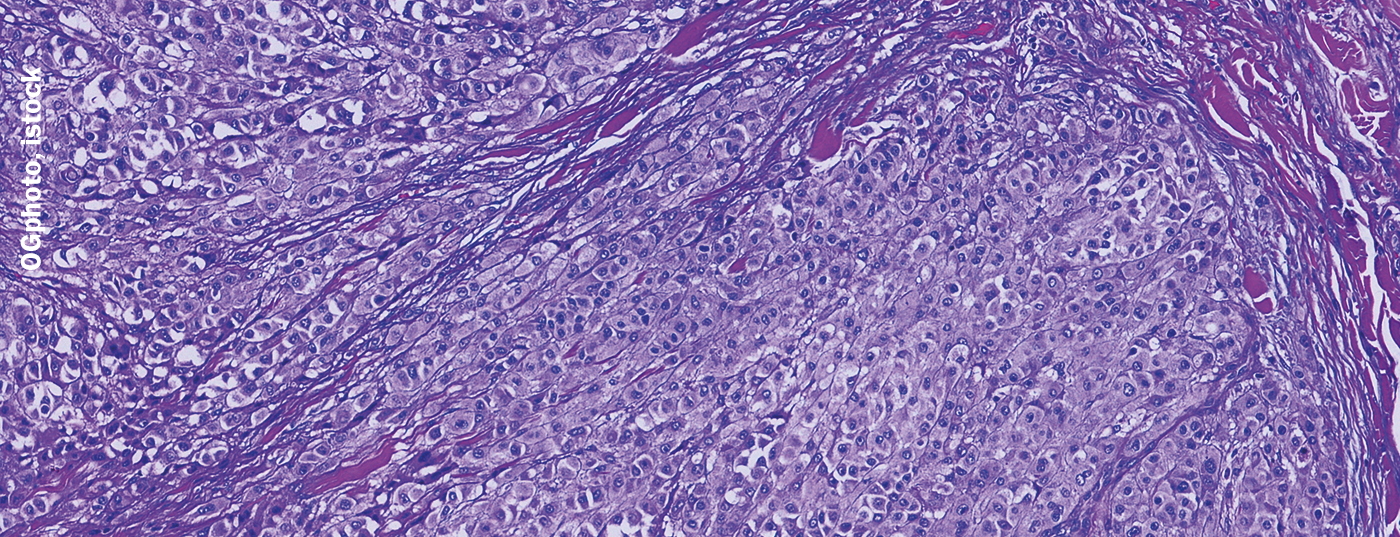After five years of follow-up in the COLUMBUS study, it is clear that patients with non-resectable or metastatic melanoma with a BRAFV600 mutation benefit long-term from encorafenib in combination with binimetinib. Thus, compared with vemurafenib monotherapy, the combination shows sustained efficacy with no new safety signals. The data were presented at the 11th European Post-Chicago Melanoma/Skin Cancer Meeting 2021.
BRAFTOVI® (encorafenib) in combination with MEKTOVI® (binimetinib) has been available since October 2018 as a modern targeted combination therapy for the treatment of adult patients with non-resectable or metastatic melanoma with a BRAFV600 mutation [1–4]. At the American Society of Clinical Oncology (ASCO) annual meeting, 5-year data from the COLUMBUS trial (box) with a follow-up of at least 65.2 months were presented for the first time [5,6]. The median follow-up in terms of overall survival was 70.4 months [7]. Prof. Christoffer Gebhardt, MD, Deputy Clinic Director and Head of the Skin Tumor Center at UKE Hamburg, led a discussion of the data at the Pierre Fabre SA press briefing at the 11th European Post-Chicago Melanoma/Skin Cancer Meeting 2021 [8].
Long-lasting efficacy under combination therapy
At the time of evaluation, median progression-free survival (PFS) of 14.9 months was confirmed with encorafenib plus binimetinib therapy. In contrast, the value for the vemurafenib-treated group was 7.3 months (HR combination vs. vemurafenib = 0.51 [95% CI; 0.40-0.67]) [7]. “The fact that the values remain stable after five years is good news, because it means that we can control the disease well with the combination therapy even in advanced stages,” Prof. Gebhardt emphasized. This is particularly evident in the PFS rate: Compared to the monotherapy with vemurafenib with 10.2%, this was 22.9% in patients treated with the combination after five years [7].
Deep response with encorafenib plus binimetinib.
The overall response rate (ORR) after central evaluation of encorafenib plus binimetinib was 64.1% (95% CI; 56.8-70.8) vs. 40.8% with vemurafenib (95% CI; 33.8-48.2) at five years [7]. Further, patients responded to combination therapy for a median of 18.6 months compared with 12.3 months with vemurafenib [7]. “The 5-year data here impressively support the profound and long-lasting response to therapy with encorafenib plus binimetinib,” Prof. Gebhardt noted, continuing, “Even more, according to central review, disease was under control in 92.2% (95% CI; 87.4-95.6) of patients on combination therapy.” This value was 81.2% (95% CI; 74.9-86.4) for vemurafenib monotherapy [7].
|
Design of the study Columbus Part I Part I of the randomized, open-label, active-controlled phase III COLUMBUS trial compared the efficacy and safety of combination therapy with encorafenib plus binimetinib to BRAF inhibitor monotherapies vemurafenib and encorafenib, respectively. Included were 577 patients with locally advanced or metastatic malignant melanoma with BRAFV600 mutation (subtype V600 E or K) who were untreated at advanced stage or had progression after one line of immunotherapy. Randomization was 1:1:1 to the following treatment arms: encorafenib 450 mg once daily + binimetinib 45 mg twice daily (COMBO450; n=192), encorafenib 300 mg once daily (ENCO300; n=194), or vemurafenib 960 mg twice daily (VEM; n=191). The primary endpoint was progression-free survival (PFS) after central evaluation with combination therapy compared with vemurafenib monotherapy. |
Clearly superior to vemurafenib in overall survival
With a median overall survival (OS) of 33.6 months (95% CI; 24.4-39.2), combination therapy is also convincing, whereas the median OS with vemurafenib was 16.9 months (95% CI; 14.0-24.5, combination vs. vemurafenib HR: 0.64 [95% CI; 0.50-0.81]) [7]. The 5-year survival rate was 34.7% (95% CI; 28.0-41.5) vs. 21.4% (95% CI; 15.7-27.8) with vemurafenib monotherapy [7]. “Over time, you can clearly see how the curves separate and also stay separate,” Prof. Gebhardt commented. In particular, patients with normal lactate dehydrogenase (LDH) levels seem to benefit more from therapy: In the current evaluation, the median OS for them was 51.7 months (95% CI; 36.8-67.3), i.e. more than four years. Patients with elevated LDH levels survived a median of 11.4 months (95% CI; 9.0- 17.4) [7].
No new safety signals
The safety data were consistent with the known profile of combination therapy, and there were no new safety signals [7]. The most common adverse events observed (≥30%; all grades) after five years on combination therapy were: Nausea (44%), Diarrhea (39%), Vomiting (33%), Fatigue (30%), and Arthralgia (30%) [7]. Side effects are generally well managed, potentially limiting new events during follow-up with encorafenib/binimetinib therapy, such as grade 3/4 fever (3.6%), were observed with rather low frequency. The combination is also superior to monotherapy with vemurafenib in terms of quality of life [9]. Concluding on the data, Prof. Gebhardt stated, “After five years, we can say: patients with a BRAFV600 mutation benefit long-lasting from therapy with encorafenib plus binimetinib.”
Source: Pierre Fabre SA
Literature:
- Drug Information, www.ema.europa.eu/en/medicines/human/EPAR/braftovi (last accessed 07/9/2021).
- Drug Information, www.ema.europa.eu/en/medicines/human/EPAR/mektovi (last accessed 07/9/2021).
- Specialist information BRAFTOVI® at www.swissmedicinfo.ch
- Technical information MEKTOVI® at www.swissmedicinfo.ch
- Dummer R, et al: Encorafenib plus binimetinib versus vemurafenib or en-corafenib in patients with BRAF-mutant melanoma (COLUMBUS): a multicentre, open-label, randomised phase 3 trial. Lancet Oncol 2018; 19(5): 603-615.
- Dummer R, et al: Overall survival in patients with BRAF-mutant me-lanoma receiving encorafenib plus binimetinib versus vemurafenib or encorafenib (COLUMBUS): a multicentre, open-label, randomised, phase 3 trial. Lancet Oncol 2018; 19(10): 1315-1327.
- Dummer R, et al: Five-year overall survival (OS) in COLUMBUS: A randomized phase 3 trial of encorafenib plus binimetinib versus vemurafenib or encorafenib in patients (pts) with BRAF V600-mutant melanoma. ASCO 2021: Abstract and Presentation #9507
- “5-year data from COLUMBUS study support continued long-term benefits,” Pierre Fabre, 7/13/2021.
- Gogas H, et al: Quality of life in patients with BRAF-mutant melanoma receiving the combination encorafenib plus binimetinib: results from a multicentre, open-label, randomised, phase III study (COLUMBUS). Eur J Cancer 2021; 152: 116-128.
- Subbiah V, Baik C, Kirkwood JM: Clinical Development of BRAF plus MEK Inhibitor Combinations. Trends Cancer 2020; 6(9): 797-810.
DERMATOLOGIE PRAXIS 2021; 31(4): 46-47











